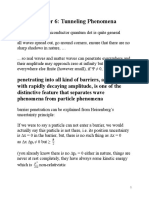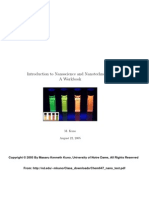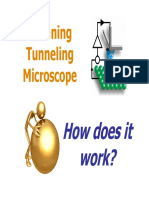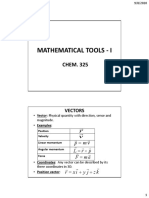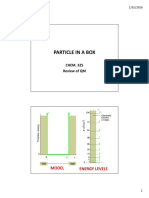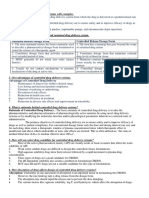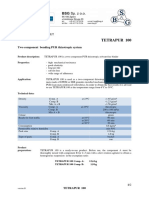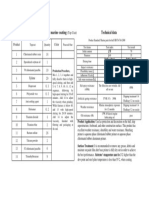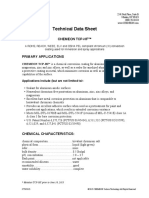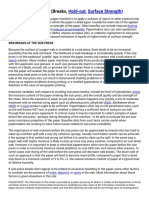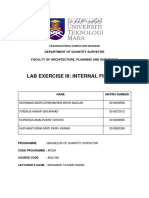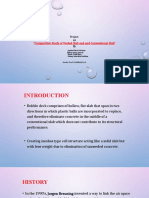Applications of the Particle-
in-a Box Model
CHEM. 325
Review of QM
Translational motion in a
chemical bond
• A model of molecular structure.
• Electron confined to a chemical bond (fixed
length L; e.g. L = 1.0 nm).
• Extension to a molecular chain of finite length.
• Conjugated molecules:
– Hydrocarbons: butadiene, hexatriene, etc.
– Dyes:
⊕ ⊕
R 3 N − CH = CH − CH = CH − NR 3
a L=ma
(14 carbons)
N
1
� – 2D-Box: naphthalene
Application of square
b box: Porphine -
• Biology: a
– β -carotene: an important biological cofactor that
participates in the absorption of solar energy in
photosynthesis; and protection against harmful
biological oxidations.
β -carotene
– Retinal (obtained from the oxidation of β-carotene in
vivo): a precursor to the pigment in the retina
responsible for vision.
Retinal
Quantum Leaks: Tunneling
• If V does not rise to ∞ when it is in the walls of
the container and E < V , then the wave function
does not decay abruptly to zero.
• The particle oscillates inside the box, varies
smoothly inside the wall region, then oscillates
again outside the wall (like a free particle).
• ∃ a small probability of finding the particle
outside, though classically it has insufficient
energy to escape!
Leakage by penetration or Tunneling
2
� • x < 0: particle with V = 0
ψ = Aeikx + Be −ikx Barrier of
1/ 2 thickness L
k = ( 2mE ) /h Oscillations
• 0 ≤ x ≤ L: particle with 0 L
E < V so V − E > 0
ψ = Ceκx + De −κx κ = [ 2m(V − E )]1/ 2 / h
Real functions: not oscillatory!
⇒ exponential decay
•x>L ψ = A′eikx + B′e − ikx
• Complete wave function:
– Incident wave
– Wave reflected from the
barrier
– Oscillating wave after
tunneling through the barrier Continuity of ψ & its derivatives
• Boundary conditions:
– Continuity of ψ
• At x = 0 A+ B = C + D
• At x = L Ceκ L + De −κ L = A′eikL + B′e −ikL
– Continuity of the derivatives of ψ
• At x = 0 ikA − ikB = κ C − κ D
• At x = L κ Ceκ L − κ De −κ L = ik A′eikL − ik B′e − ikL
3
� • No particles traveling to the left on the right of
the barrier! B’ = 0
• Some particles may be reflected back from the
barrier. B≠0
• Transmission Probability:
| A′ |2
T=
| A |2 ε =E/V
– Can show that:
−1
( eκ L − e −κ L ) 2
T = 1 +
16 ε (1 − ε )
– For high and
wide barriers
(κL >> 1):
T ≈ 16 ε (1 − ε )e −2κ L
Notes / Applications of tunneling
• The transmission probability
depends on the mass of the
projectile and the width of the
barrier.
• Low mass projectiles are more
likely to tunnel.
• Once outside the wall the wave
function oscillates like a free
particle.
• In Chemical Kinetics: “Tunnel”
is dug through the Activation E
Energy barrier! Eact
• Kinetic isotope effect: H as a
higher tunneling probability than
D.
progress
4
� The Scanning Tunneling Microscope (STM)
• Pt/Rh/W needle scans the surface of a
conducting solid.
• As the tip of the stylus is brought very
close to the surface, electrons tunnel
through the space between them.
• Current flown (tunneling probability)
depends on the distance gap. It thus
varies with the topology of the
surface.
• ⇒ The microscope can detect very
tiny variations in the height of the
surface.
• Allows the study of the atomic and
molecular assemblies of sizes between
1 nm and 100 nm. Nanoscience
• Nanotechnology: incorporation of
such assemblies into devices.
STM image, 35 nm x 35 nm, of single
substitutional Cr impurities (small bumps)
STM image, 7 nm x 7 nm, of a
in the Fe(001) surface.
single zig-zag chain of Cs atoms (red)
on the GaAs(110) surface (blue).
Image of reconstruction on a clean Gold surface.
5
�Another powerful STM capability is the ability to
move atoms and molecules.
This is achieved by placing the tip close enough
to the surface adsorbate so that the
tip-adsorbate attraction is comparable to the
surface corrugation barrier. In this regime,
the molecule will follow the tip wherever it is
moved along the surface.
One can then retract the tip, without causing the
molecule to desorb from the surface.















